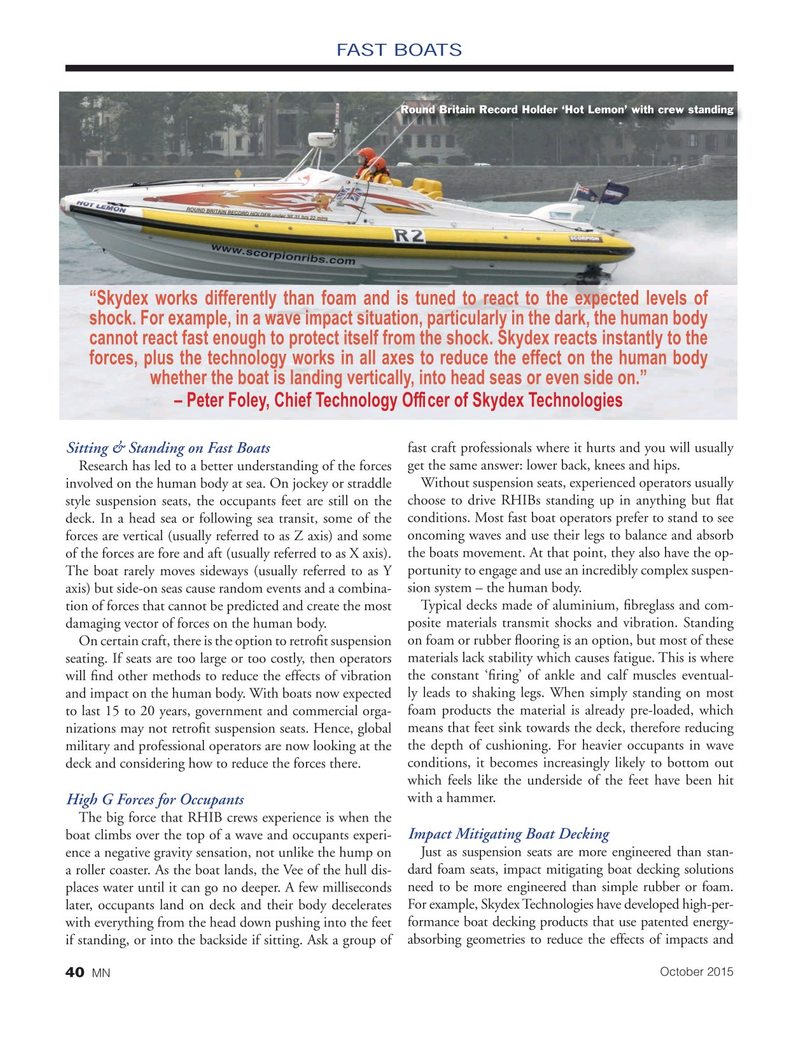
Page 40: of Marine News Magazine (October 2015)
Salvage & Spill Response
Read this page in Pdf, Flash or Html5 edition of October 2015 Marine News Magazine
FAST BOATS
Round Britain Record Holder ‘Hot Lemon’ with crew standing “Skydex works differently than foam and is tuned to react to the expected levels of shock. For example, in a wave impact situation, particularly in the dark, the human body cannot react fast enough to protect itself from the shock. Skydex reacts instantly to the forces, plus the technology works in all axes to reduce the effect on the human body whether the boat is landing vertically, into head seas or even side on.” – Peter Foley, Chief Technology Of? cer of Skydex Technologies fast craft professionals where it hurts and you will usually
Sitting & Standing on Fast Boats
Research has led to a better understanding of the forces get the same answer: lower back, knees and hips.
involved on the human body at sea. On jockey or straddle Without suspension seats, experienced operators usually style suspension seats, the occupants feet are still on the choose to drive RHIBs standing up in anything but ? at deck. In a head sea or following sea transit, some of the conditions. Most fast boat operators prefer to stand to see forces are vertical (usually referred to as Z axis) and some oncoming waves and use their legs to balance and absorb of the forces are fore and aft (usually referred to as X axis). the boats movement. At that point, they also have the op-
The boat rarely moves sideways (usually referred to as Y portunity to engage and use an incredibly complex suspen- axis) but side-on seas cause random events and a combina- sion system – the human body.
tion of forces that cannot be predicted and create the most Typical decks made of aluminium, ? breglass and com- damaging vector of forces on the human body. posite materials transmit shocks and vibration. Standing
On certain craft, there is the option to retro? t suspension on foam or rubber ? ooring is an option, but most of these seating. If seats are too large or too costly, then operators materials lack stability which causes fatigue. This is where will ? nd other methods to reduce the effects of vibration the constant ‘? ring’ of ankle and calf muscles eventual- and impact on the human body. With boats now expected ly leads to shaking legs. When simply standing on most to last 15 to 20 years, government and commercial orga- foam products the material is already pre-loaded, which nizations may not retro? t suspension seats. Hence, global means that feet sink towards the deck, therefore reducing military and professional operators are now looking at the the depth of cushioning. For heavier occupants in wave deck and considering how to reduce the forces there. conditions, it becomes increasingly likely to bottom out which feels like the underside of the feet have been hit with a hammer.
High G Forces for Occupants
The big force that RHIB crews experience is when the
Impact Mitigating Boat Decking boat climbs over the top of a wave and occupants experi- ence a negative gravity sensation, not unlike the hump on Just as suspension seats are more engineered than stan- a roller coaster. As the boat lands, the Vee of the hull dis- dard foam seats, impact mitigating boat decking solutions places water until it can go no deeper. A few milliseconds need to be more engineered than simple rubber or foam. later, occupants land on deck and their body decelerates For example, Skydex Technologies have developed high-per- with everything from the head down pushing into the feet formance boat decking products that use patented energy- if standing, or into the backside if sitting. Ask a group of absorbing geometries to reduce the effects of impacts and
October 2015
MN 40
MN Oct15 Layout 32-49.indd 40 9/21/2015 11:25:04 AM

 39
39

 41
41
